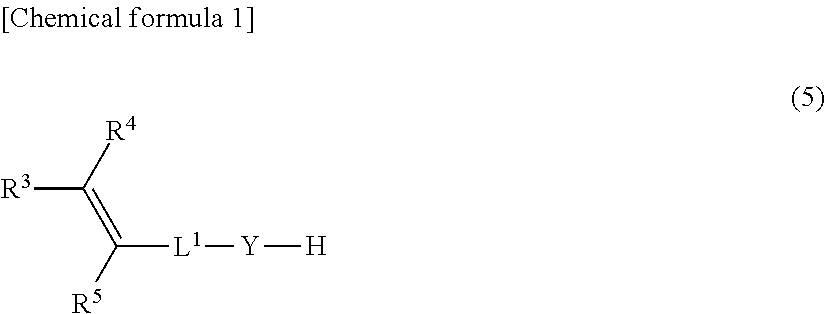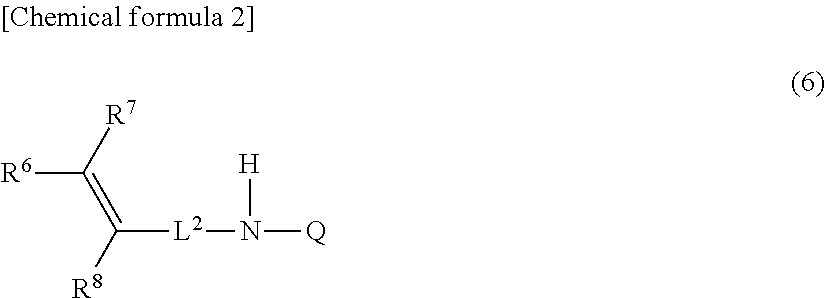Ring-opening polymer of cyclopentene and method of production of same
a cyclopentane and polymer technology, applied in the field of cyclopentane ring-opening polymer, can solve the problems of poor heat generation property, inability to use various rubbers, poor rubber properties, etc., and achieve excellent rubber properties, low heat generation properties, and excellent proccessability and a rubber composition.
- Summary
- Abstract
- Description
- Claims
- Application Information
AI Technical Summary
Benefits of technology
Problems solved by technology
Method used
Image
Examples
reference example 1
[0137]Preparation of diisobutyl aluminum mono(n-hexoxide) / toluene solution (2.5 wt %)
[0138]Under the nitrogen atmosphere, 88 parts of toluene and 7.8 parts of 25.4 wt % of triisobutyl aluminum / n-hexane solution (made by TOSOH FINECHEM CORPORATION) were added to a glass vessel containing a stir bar. After cooling to −45° C., 1.02 parts of n-hexanol (the same molar amount as triisobutyl aluminum) were slowly added dropwise under vigorous stirring. After that, the mixture was kept under stirring until it reached the room temperature to prepare diisobutyl aluminum mono(n-hexoxide) / toluene solution (2.5 wt %) as the organoaluminum compound (a2) containing alkoxy group.
example 1
[0139]Under the nitrogen atmosphere, 173 parts of toluene and 13.8 parts of 25.4 wt % of triisobutyl aluminum / n-hexane solution (made by TOSOH FINECHEM CORPORATION) as the alkyl aluminum (b2) were added to a glass vessel containing a stir bar. Subsequently, after cooling to −45° C., 1.27 parts of 3-buten-1-ol (the same molar amount as triisobutyl aluminum) as the olefin compound (b1) were slowly added dropwise under vigorous stirring. After that, the mixture was kept under stirring until it reached the room temperature to obtain the solution of the reactant (B) of triisobutyl aluminum and 3-buten-1-ol.
[0140]Subsequently, under the nitrogen atmosphere, 43 parts of 2.0 wt % of WCl6 / toluene solution as the compound (a1) of a transition metal belonging to Group 6 in the Periodic Table and 48 parts of the solution of the reactant (B) of triisobutyl aluminum and 3-buten-1-ol obtained above were added to a pressure resistant glass reaction vessel equipped with a stirrer and stirred for 10 ...
example 2
[0143]Under the nitrogen atmosphere, 150 parts of cyclopentene and 3.5 parts of 25.4 wt % of triisobutyl aluminum / n-hexane solution (mande by TOSOH FINECHEM CORPORATION) as the alkyl aluminum (b2) were added to a pressure resistant glass reaction vessel equipped with a stirrer. Subsequently, 0.45 part of 5-hexen-1-ol (the same molar amount as triisobutyl aluminum) as the olefin compound (b1) were slowly added dropwise thereto under vigorous stirring to obtain the solution containing cyclopentene and the reactant (B) of triisobutyl aluminum and 5-hexen-1-ol. Subsequently, 21 parts of 2.0 wt % of WCl / toluene solution as the compound (a1) of a transition metal belonging to Group 6 in the Periodic Table were added to the solution obtained and the polymerization reaction was allowed to occur for 6 hours at 25° C. After 6 hours of the polymerization reaction, termination of the polymerization reaction, recovery of the polymer, washing and vacuum drying were carried out in the same manner ...
PUM
| Property | Measurement | Unit |
|---|---|---|
| glass transition temperature | aaaaa | aaaaa |
| dispersity | aaaaa | aaaaa |
| temperature | aaaaa | aaaaa |
Abstract
Description
Claims
Application Information
 Login to View More
Login to View More - R&D
- Intellectual Property
- Life Sciences
- Materials
- Tech Scout
- Unparalleled Data Quality
- Higher Quality Content
- 60% Fewer Hallucinations
Browse by: Latest US Patents, China's latest patents, Technical Efficacy Thesaurus, Application Domain, Technology Topic, Popular Technical Reports.
© 2025 PatSnap. All rights reserved.Legal|Privacy policy|Modern Slavery Act Transparency Statement|Sitemap|About US| Contact US: help@patsnap.com



